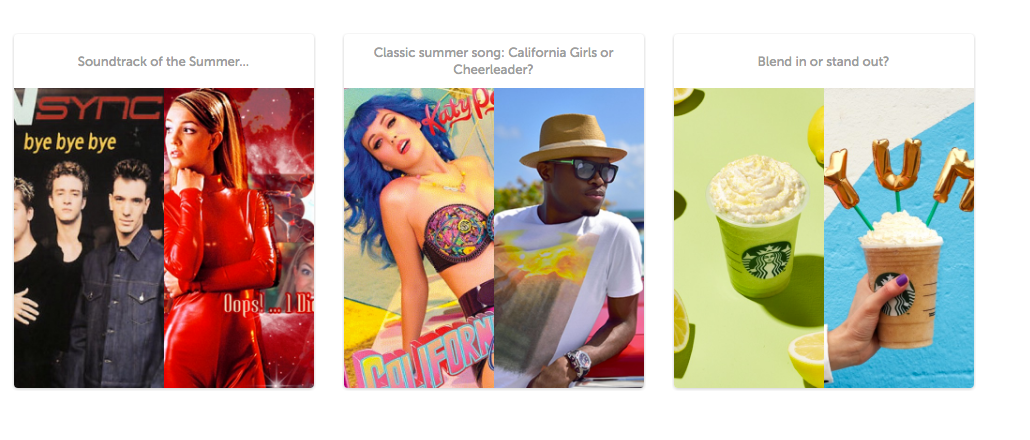
Kim or Kourtney? Contouring or strobing? Iced coffee or frappuccino? Wishbone, a tap-to-vote mobile app, invites users to take breezy hot-or-not polls about pop culture news, makeup trends and other teenage obscura. It’s attracting teens by the millions. And where teens go, brands are soon to follow.
In a little over a year since its launch, Wishbone says it has attracted an audience of 4 million monthly active users, with the majority being girls between the ages of 13 and 18 years old. That itself has been enough to attract a range of brands — from Victoria’s Secret Pink and Sephora to Dunkin’ Donuts and Starbucks — which have begun experimenting there. (Oddly, Wish-Bone, the salad dressing brand, isn’t on Wishbone yet.)
“Wishbone allows entertainment brands to eavesdrop on millions of teenage debates — creating an unprecedented new way of analyzing their preference,” Michael Jones, the Wishbone CEO (and former CEO of MySpace), recently wrote on Medium. “Our polling model doubles nicely as an instant market research tool for any given topic.”
Brands have gotten directly involved by pushing out organic polls from their own branded, verified accounts. Seventeen, for instance, has been pushing out prom-themed polls or “cards” as they are called on the platform, such as “Love or Hate: Promposals,” from its verified account. Seventeen is not a paid sponsor. Sephora has also been riding the “promposal” trend with its own Wishbone polling — some of it paid for by the brand.

Another way for brands to get noticed is the “Daily Dozen,” a set of 12 cards presented to users twice a day as soon as they open the app. These cards are either selected by Wishbone curators or inserted into the deck when a brand pays for a sponsorship. Taco Bell made its Wishbone debut through sponsored cards for its revamped $1 breakfast menu in March– teasing users with photos of a $1 and a $5 bill and the question “What’s a better price for breakfast?” Each of its sponsored cards garnered hundreds of thousands of votes, as opposed to the non-sponsored ones which get at most a few thousand.
“The idea behind our launch was truly around choice, and that’s what Wishbone brings to life,” said Jozlynn Rush, Taco Bell’s social and digital experience manager. “We were able to poll our fans and get instant feedback in a fun and engaging way — and the results helped us drive how we communicated the launch of our $1 Breakfast Value Menu.”
Dunkin’ Donuts and Starbucks have more recently made their forays into the app. While Dunkin’ Donuts began posting polls last week and hasn’t sponsored any cards until now, Starbucks’s account “Frappuccino” was prominently featured on sponsored cards in the Daily Dozen on May 9.
“The simplicity of the Wishbone platform is really the key, and we see it as a fun way for teens and young adults to pass time,” said Melanie Cohn, social media manager at Dunkin’ Donuts. “Our fans naturally debate about their favorite Dunkin’ products, for example, ‘Donuts or Coffee?’ or ‘Iced or Hot?’ and Wishbone highlights these conversations in a fun and quick way — giving us a special peek into how users feel.”
Weekend activity: Morning hike or Ride? Tell us on @WishboneApp! Just add “dunkindonuts” pic.twitter.com/cm6aXHvMoB
— Dunkin’ Donuts (@DunkinDonuts) May 6, 2016
One advantage of Wishbone is that it is relatively frictionless compared to a range of other apps, said Ben Kosinski, head of The Collaboratory at iCrossing. “The user experience is very unique in that you don’t necessarily have to create a username to vote — only for additional features like DMs,” he said. “It reduces a lot of friction and makes it so simple — It’s the digital equivalent of raising your hand in a class full of people.”
Alongside sponsored cards, Wishbone also weaves in non-skippable video ads in between polls. While these are primarily being used by a few mobile game makers like “1010!” thus far, it’s also an avenue brands can explore. Brands can also insert themselves into conversations by buying search terms like “lipstick” on the platform as well as having their specific product images served at the top in polls.
With the market for in-app ad placements almost doubling to $30 billion this year from $13.7 billion in 2014, according to eMarketer data, Wishbone’s prospects look good. But brands need to go beyond treating it as a “This or That” version of Instagram, said Zach Gallagher, evp and director of digital strategy at Deutsch Los Angeles. Data from a Ypulse survey from March found that teens are not particularly fond of in-app advertising.
“I think it’s a lot more interesting to think about a tension that a brand can play with,” he said. “The requirement to choose has inherent tension in it, and I think there’s great opportunity to lean into that and do work that makes people stop and take notice.”
More in Marketing

Zero-click search is changing how small brands show up online — and spend
To appease the AI powers that be, brands are prioritizing things like blogs, brand content and landing pages.

More creators, less money: Creator economy expansion leaves mid-tier creators behind
As brands get pickier and budgets tighten, mid-tier creators are finding fewer deals in the booming influencer economy.

‘Still not a top tier ad platform’: Advertisers on Linda Yaccarino’s departure as CEO of X
Linda Yaccarino — the CEO who was never really in charge.





